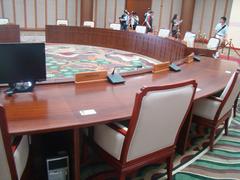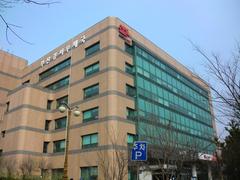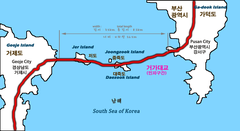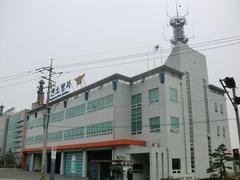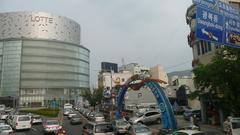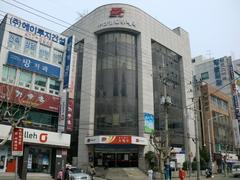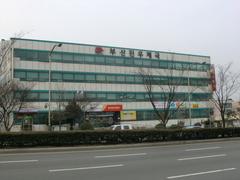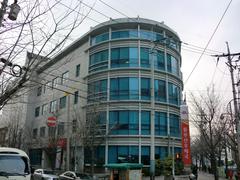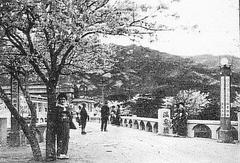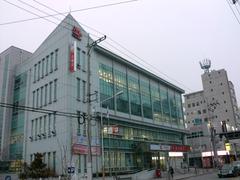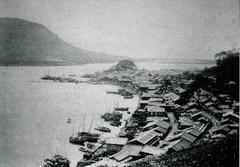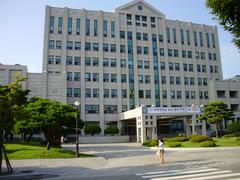
Busan Saha Police Station Visiting Hours, Tickets, and Guide to Busan Historical Sites
Date: 03/07/2025
Introduction to Busan Saha Police Station and Its Significance
Located in the bustling district of Saha-gu in southwestern Busan, South Korea, the Busan Saha Police Station plays a dual role as both a guardian of public safety and a vital supporter of the community’s cultural landscape. Established during Busan’s late 20th-century urban expansion, this station serves over 300,000 residents across residential, industrial, and cultural neighborhoods, including the celebrated Gamcheon Culture Village. This guide provides a thorough overview of the Busan Saha Police Station, from its origins and evolution to practical visitor information and its connection to nearby historical and cultural attractions. Whether you are a resident seeking services, a traveler exploring Saha-gu, or a culture enthusiast, understanding the station’s context enhances your experience in this vibrant part of Busan.
For more official details and travel tips, consult the Minwon25 guide and insights from Seoul Korea Asia on Gamcheon Culture Village.
Contents
- Introduction
- History and Establishment of Busan Saha Police Station
- Development and Key Milestones
- Community Integration Post-Korean War
- Modernization and Growth
- Adapting to Social and Cultural Change
- Organizational Structure and Community Role
- Visitor Information
- Visiting Hours and Access
- Directions and Accessibility
- Nearby Historical and Cultural Sites
- Notable Community Contributions
- Frequently Asked Questions (FAQ)
- Visuals and Media
- Conclusion
History and Establishment of Busan Saha Police Station
The Busan Saha Police Station emerged amid Busan’s rapid urbanization, aiming to decentralize and modernize law enforcement for an expanding and diverse population. Since its inception, the station has played a pivotal role in serving the unique needs of Saha-gu’s neighborhoods, including areas now famed for their cultural significance, such as Gamcheon Culture Village (seoulkoreaasia.com).
Community Integration Post-Korean War
After the Korean War, Saha-gu became a refuge for displaced people, with informal settlements that gradually evolved into established communities. The police station provided essential stability during these formative years, supporting social order as districts like Gamcheon-dong transformed (heyroseanne.com).
Modernization and Growth
Throughout the 1980s and 1990s, the station expanded its facilities and adopted new technologies to meet growing demands. The opening of Saha Station on Busan Metro Line 1 in 1994 (en.wikipedia.org) further increased accessibility and necessitated expanded police services.
Adapting to Social and Cultural Change
As Saha-gu evolved into a cultural hub, particularly with the rise of Gamcheon Culture Village as a tourist destination, the police station adapted by introducing multilingual support and launching community-oriented policing initiatives. Officers are specially trained to interact with visitors and support public safety during major festivals and busy tourist periods (seoulkoreaasia.com).
Organizational Structure and Community Role
Busan Saha Police Station is organized into several divisions, including Criminal Investigation, Traffic, Community Policing, and a specialized Tourism and Cultural Affairs unit to accommodate the district’s growing visitor base. Police boxes (“chulso”) are strategically located throughout Saha-gu, ensuring rapid response and high visibility (en.namu.wiki).
Visitor Information
Visiting Hours and Access
- Administrative Services: Open Monday to Friday, 9:00 AM to 6:00 PM.
- Emergency Desk: Open 24/7 for urgent needs.
- Public Tours: Not available; the facility is not a tourist attraction, but visitors may enter for official business.
Directions and Accessibility
- Metro: Take Busan Metro Line 1 to Saha Station. The station is a short walk away.
- Buses: Multiple city bus routes serve the area (koreatravelplanning.com).
- Accessibility: The police station is wheelchair accessible, and staff can assist visitors with disabilities.
Nearby Historical and Cultural Sites
- Gamcheon Culture Village: Famous for its vibrant art, murals, and panoramic views (seoulkoreaasia.com).
- Dadaepo Beach: A scenic beach ideal for relaxation and outdoor activities.
- Busan Modern History Museum: Offers exhibitions on the city’s development and heritage.
Notable Community Contributions
Busan Saha Police Station is recognized for its effective crisis response during natural disasters, such as typhoons, and for supporting vulnerable residents through welfare checks, crime prevention programs, and community engagement (heyroseanne.com).
Frequently Asked Questions (FAQ)
Q: What are the visiting hours of Busan Saha Police Station?
A: Administrative services are available Monday to Friday, 9:00 AM to 6:00 PM. Emergency services operate 24/7.
Q: Can tourists take a public tour of the station?
A: No, the police station does not provide public tours.
Q: How can I get to the station?
A: Use Saha Station (Metro Line 1) or local buses for easy access.
Q: Is English language support available?
A: Some officers speak basic English, but it’s advisable to bring a Korean-speaking companion or use translation apps.
Visuals and Media
Explore high-quality images and maps of Saha Police Station and nearby attractions on our website. Virtual tours of cultural sites, such as Gamcheon Culture Village, are also available to help you plan your visit.
Conclusion
Busan Saha Police Station is a vital institution at the heart of Saha-gu, ensuring safety and fostering community well-being as the district continues to grow and diversify. While not a tourist attraction, understanding its services and role enhances your experience and security during your stay in Busan. Take advantage of its proximity to cultural highlights for a well-rounded visit.
For more information, download the Audiala app and follow us on social media for the latest updates and travel tips.
Visiting Gamcheon Culture Village: Hours, Tickets, and Tips
Introduction
Gamcheon Culture Village, often referred to as the “Machu Picchu of Busan,” is renowned for its colorful hillside houses, vibrant murals, and creative spirit. It offers visitors an immersive blend of history, art, and local culture, making it a must-see destination in Busan.
Historical Background
Founded by refugees after the Korean War, Gamcheon Culture Village has transformed from a modest settlement into a dynamic cultural landmark. With support from local artists and the city, the area now features public art, galleries, and community spaces that attract visitors from around the world.
Visiting Hours and Tickets
- Hours: Open daily, 9:00 AM to 6:00 PM.
- Admission: Entry is free; select galleries and exhibitions may charge a fee (2,000–5,000 KRW).
- Guided Tours: Available for approximately 15,000 KRW per person; book at the visitor center or online.
Getting There
- By Subway: Take Line 1 to Toseong Station, Exit 6, then Bus No. 2 or 2-2 to Gamcheon Elementary School stop.
- By Bus: Several routes serve the area; check local schedules.
- Accessibility: The village’s steep, narrow streets are challenging for those with mobility impairments; wear comfortable shoes.
Travel Tips
- Best Seasons: Spring and autumn for pleasant weather and vibrant scenery.
- Photo Spots: Seek out mural alleys and panoramic viewpoints.
- Local Shops and Cafes: Enjoy handmade crafts and refreshments in charming settings.
- Respect the Community: Keep noise down and respect residents’ privacy.
Nearby Attractions
- Busan Tower & Yongdusan Park: Offers stunning city views.
- Jagalchi Fish Market: Experience Busan’s seafood culture.
- Dadaepo Beach: Perfect for relaxing after a day of sightseeing.
Special Events
Look for the annual Gamcheon Culture Festival every October, featuring performances, workshops, and nighttime illuminations.
FAQs
Q: Is there an entrance fee?
A: No, entry is free; some exhibitions may have a separate charge.
Q: Are guided tours available?
A: Yes, in Korean and English; book ahead if needed.
Q: Is the village family-friendly?
A: Yes, but be cautious on steep stairways.
Q: What languages are tours offered in?
A: Mainly Korean and English.
Conclusion
Gamcheon Culture Village is a highlight of Busan, combining history, art, and local life in a uniquely vibrant setting.
For more details, visit the official Gamcheon Culture Village website.
Discovering the Saha Monument: Busan’s Historical Landmark
Overview
The Saha Monument, situated in Saha-gu, honors the district’s resilience and development. Its striking architecture and landscaped gardens make it a popular destination for history buffs and families alike.
Visiting Hours and Tickets
- Hours: Open daily, 9:00 AM to 6:00 PM (last admission 5:30 PM).
- Admission: Free.
- Guided Tours: Available on weekends and public holidays.
Getting There
- Public Transit: Metro Line 1 to Saha Station, then a 10-minute walk.
- Driving: Ample parking available.
- Accessibility: Fully wheelchair accessible.
Highlights
- Beautiful gardens and informational plaques.
- Interactive digital kiosks.
- Seasonal cultural events and workshops.
Nearby Amenities
- Saha Market for local cuisine and crafts.
- Busan Museum of Art.
- Nearby cafes and restaurants.
Tips
- Visit early for a quieter experience.
- Join a guided tour for deeper insight.
- Check the Busan Tourism Official Site for event updates.
FAQs
Q: Is entrance free?
A: Yes.
Q: Are there programs for children?
A: Yes, including educational workshops.
Q: Is photography allowed?
A: Yes, except in restricted areas.
Q: How do I get there by public transit?
A: Metro Line 1 to Saha Station, then a short walk.
Conclusion
The Saha Monument is a rewarding stop for anyone exploring Busan’s history and culture.
For more, visit the Busan Tourism Official Site.
Saha Police Station Practical Guide
Location and Contacts
- Address: 부산광역시 사하구 (Saha-gu, Busan Metropolitan City)
- Transport: Closest metro stops—Sinpyeong and Hadan Stations (Line 1). From there, take a bus or taxi. Carry the address in Korean.
- General Inquiry Phone: Listed on the Minwon25 page.
- Emergency Number: Dial 112 for police assistance.
Hours and Services
- Administrative Hours: 09:00–18:00, Monday to Friday.
- Emergency Desk: 24/7.
Services
- Lost and found, incident and crime reporting, limited English assistance.
- Traffic accident reporting and fine payment.
- Crime prevention, victim support, and welfare checks.
- Resident registration support for foreigners.
What to Expect
- Bring identification and relevant documents.
- Security screening is standard; photography is restricted.
- Limited language support—use translation apps or come with a Korean speaker.
Tips for Tourists
- For emergencies, dial 112 (police) or 119 (fire/medical).
- Report lost property as soon as possible.
- Be polite and dress modestly.
- Ask about accessibility if needed.
Safety in Saha-gu
Saha-gu is a safe district, with proactive law enforcement. Recent laws have increased penalties for weapons in public (Haps Korea).
Nearby Facilities
Convenience stores, cafes, and public transport stops are located near the station.
Conclusion and Travel Advice
Busan Saha Police Station is an essential institution supporting the safety and daily life of Saha-gu’s diverse communities. Visitors benefit from understanding its services and accessibility, especially when combining practical needs with explorations of nearby cultural sites like Gamcheon Culture Village and the Saha Monument. For authoritative information and updates, check the official Saha Police Station website and the Busan Tourism Official Site.
Download the Audiala app for personalized guides, real-time updates, and insider travel tips. Stay connected on social media for the latest news about Busan’s top attractions.
References
- Gamcheon Culture Village – Seoul Korea Asia
- Official Gamcheon Culture Village Website
- Busan Tourism Official Site
- Minwon25: Saha Police Station Visitor Guide
- Haps Korea – Weapons Law Update
- Saha Station Wikipedia
- Namu Wiki – Saha Police Station
- Korea Travel Planning – Busan Transportation
- Hey Roseanne – Gamcheon Culture Village


